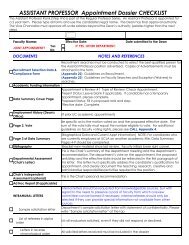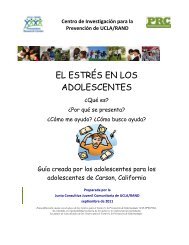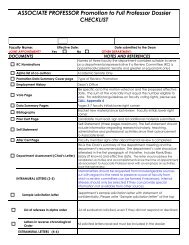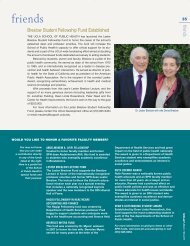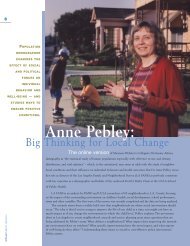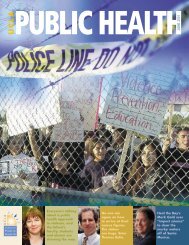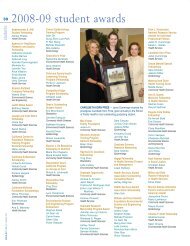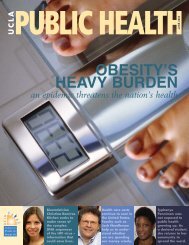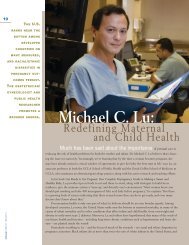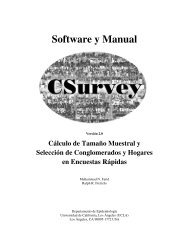A BROADER VIEWOF HEALTH: - UCLA School of Public Health
A BROADER VIEWOF HEALTH: - UCLA School of Public Health
A BROADER VIEWOF HEALTH: - UCLA School of Public Health
Create successful ePaper yourself
Turn your PDF publications into a flip-book with our unique Google optimized e-Paper software.
and lesbian and gay employees. their study, whose findings were published in<br />
the journal <strong>Health</strong> Affairs, concludes that sexual-orientation disparities are<br />
greater than previously thought. Partnered gay men living in California, for example,<br />
are only 42 percent as likely as married heterosexual men to receive<br />
employer-sponsored dependent health insurance, while partnered lesbians have<br />
an even smaller chance – 28 percent – <strong>of</strong> getting coverage compared to married<br />
heterosexual women.<br />
the report used data from the California health Interview Survey. the<br />
researchers combined three years <strong>of</strong> adult surveys: 2001, 2003 and 2005. the<br />
final sample included 63,719 women and 46,535 men between the ages <strong>of</strong> 18<br />
and 64. <strong>of</strong> the sample, 51 percent <strong>of</strong> lesbians and 38 percent <strong>of</strong> gay men<br />
reported being in a partnered or married relationship, compared with 64 percent<br />
<strong>of</strong> female and 64 percent <strong>of</strong> male heterosexuals.<br />
“we found no strong evidence to suggest that California<br />
employers are discriminating in providing health insurance to gay<br />
and lesbian workers as individuals,” says Ponce, an associate<br />
pr<strong>of</strong>essor at the school. “however, we did find that employers<br />
were setting coverage rules for dependents that favored legally<br />
and heterosexually married employees.”<br />
the authors noted that most <strong>of</strong> the data were collected<br />
before full implementation <strong>of</strong> the California Insurance equality Act<br />
<strong>of</strong> 2005; they expect that the law, once fully enacted and combined<br />
with the federal Patient Protection and Affordable Care Act,<br />
may alleviate some <strong>of</strong> the disparities documented in their study.<br />
But they also noted that the way government agencies and<br />
employers define dependents, and the federal taxation <strong>of</strong> health<br />
benefits for a same-sex spouse or partner, continue to be “a relevant<br />
underlying structural determinant <strong>of</strong> whether or to what<br />
extent sexual-orientation minorities will have more equal access<br />
to employer-sponsored insurance.”<br />
Achieving universal coverage, Ponce says, "will depend in<br />
part on remedying inequalities in state and federal marriagerelated<br />
rules."<br />
Nanoparticles in Common Household Items<br />
Cause Genetic Damage in Mice<br />
tItAnIUM DIoxIDe (tIo2) nAnoPArtICLeS, found in everything from cosmetics<br />
and sunscreen to paint and vitamins, cause systemic genetic damage in<br />
mice, according to a comprehensive study conducted by researchers at <strong>UCLA</strong>’s<br />
Jonsson Comprehensive Cancer Center and <strong>School</strong> <strong>of</strong> <strong>Public</strong> health.<br />
the tio2 nanoparticles induced single- and double-strand DnA breaks and<br />
also caused chromosomal damage as well as inflammation, all <strong>of</strong> which increase<br />
the risk for cancer. the study, published in the journal Cancer Research, was the<br />
first to show that the nanoparticles had such an effect, according to Dr. robert<br />
Schiestl, a Jonsson Cancer Center scientist and pr<strong>of</strong>essor in the <strong>School</strong> <strong>of</strong> <strong>Public</strong><br />
health, who was the study’s senior author.<br />
once in the system, the tio2 nanoparticles accumulate in different organs<br />
because the body has no way to eliminate them. And because they are so small,<br />
they can go everywhere in the body, even through cells, and may interfere with<br />
sub-cellular mechanisms, Schiestl’s team noted.<br />
In the past, these tio2 nanoparticles have been considered non-toxic in that<br />
they do not incite a chemical reaction. Instead, it is surface interactions that the<br />
nanoparticles have within their environment – in this case, inside a mouse – that<br />
is causing the genetic damage, Schiestl says. they wander throughout the body<br />
causing oxidative stress, which can lead to cell death.<br />
It is a novel mechanism <strong>of</strong> toxicity, a physicochemical reaction, that these<br />
particles cause in comparison to regular chemical toxins, which are the usual<br />
subjects <strong>of</strong> toxicological research. “the novel principle is that titanium by itself is<br />
Partnered gay men living in California are only<br />
42 percent as likely as married heterosexual men<br />
to receive employer-sponsored dependent health<br />
insurance, while partnered lesbians have an even<br />
smaller chance – 28 percent – <strong>of</strong> getting coverage<br />
compared to married heterosexual women.<br />
25<br />
research <strong>UCLA</strong>PUBLIC <strong>HEALTH</strong>



